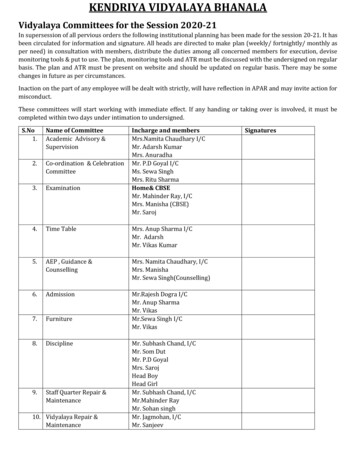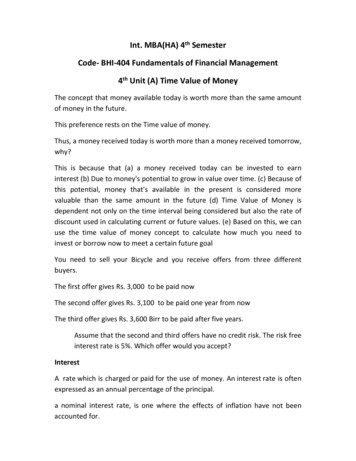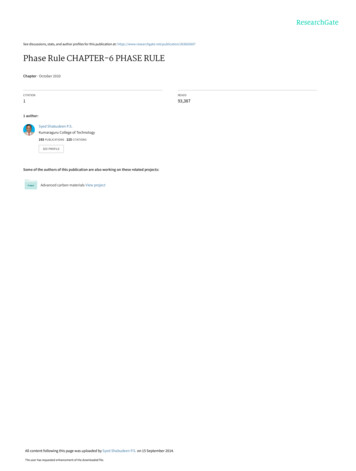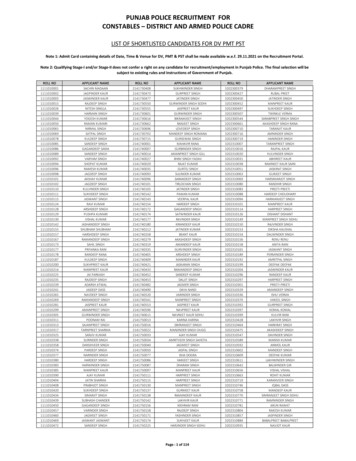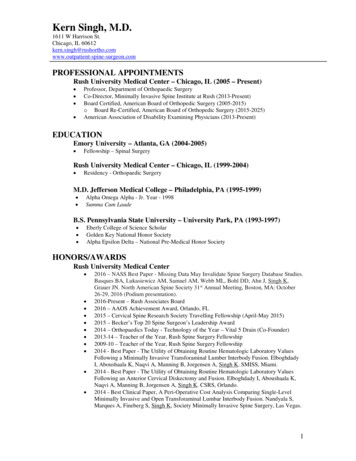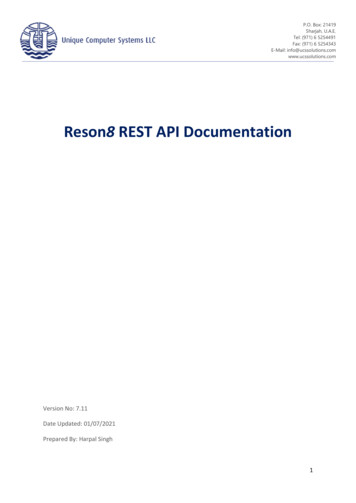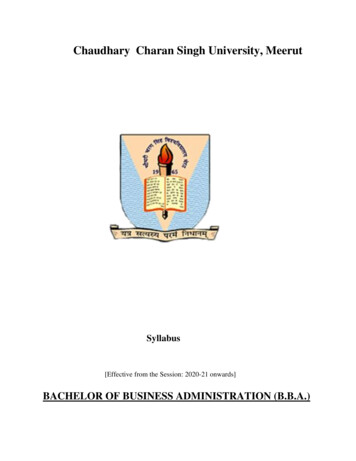
Transcription
Chaudhary Charan Singh University, MeerutSyllabus[Effective from the Session: 2020-21 onwards]BACHELOR OF BUSINESS ADMINISTRATION (B.B.A.)
Chaudhary Charan Singh University, MeerutTHREE YEARS BACHELOR OF BUSINESS ADMINISTRATION (B.B.A.) PROGRAMMECOURSE CONTENTSSEMESTER – ITheoryBBA-101:Fundamentals of nagerial EconomicsBBA-104: Accounting and Financial AnalysisBBA-105:Business LawBBA-106:BusinessOrganization and EthicsBBA-008: Environmental Studies (Qualifying 252525252525100100100100100100100INT.TotalSEMESTER – IIBBA-201:Quantitative Techniques for BusinessBBA-202:Business CommunicationBBA-203:Human Resource ManagementBBA-204: Marketing ManagementBBA-205 :Business EnvironmentBBA-206: Fundamentals of ComputerBBA-207:Assessments on Soft Skill Based onPresentations/ G.D/ Personality traitsSEMESTER – IIIBBA-301:Advertising ManagementBBA-302:Team Building & LeadershipBBA-303 Indian EconomyBBA-304:Customer Relationship ManagementBBA-305:Management Information SystemBBA-306:Income Tax Law & practiceSEMESTER – IVBBA-401:ConsumerBehaviorBBA-402:Financial ManagementBBA-403:Production& Operation ManagementBBA-404:Sales& Distribution ManagementBBA-405:Research MethodologyBBA-406:Entrepreneurship& Small Business ManagementBBA-407:Computer Oriented Practical &Viva- Voce
SEMESTER – VBBA-501:Arithmetic Aptitude75BBA-502:Aptitude Reasoning75BBA-503:General Business Awareness75BBA-504:General English75BBA-505:Elective Paper M-1/ F-175BBA-506:Elective Paper M-2 / F-275BBA-507:Summer Training Project Report based Viva- Voce252525252525100100100100100100100Note: Paper code BBA-501, BBA-502, BBA-503 and BBA-504 will be of multiple-choice objectivetype questions.SEMESTER – VIBBA-601:Strategic Management & Business PolicyBBA-602:Operation ResearchBBA-603:Fundamentals of E CommerceBBA-604:Economic and Industrial LawBBA-605:Elective Paper M-3/ F-3BBA-606:Elective Paper M-4/ F-4BBA-607: Comprehensive Viva-Voce757575757575The Elective papers in the functional specialization will be as follows:Marketing:M-1 Rural MarketingM-2 Service MarketingM-3 Retail ManagementM-4 Digital MarketingFinance:F-1 Corporate Taxes-Direct and Indirect TaxF-2 Financial Institutions & Investment ManagementF-3 Cost and Management AccountingF-4 Company Accounts252525252525100100100100100100100
COURSE CONTENT FOR SEMESTER – IBBA-101: FUNDAMENTALS OF MANAGEMENTUnit – I: Introduction Concepts, Objectives, Nature Scope and Significance of management Evolutionof management thought- Contribution of Taylor, Weber and Fayol management.Unit – II: Planning: Concept, Objectives, Nature, Limitation, Process of planning, Importance, Forms,Techniques and Process of decision making.Unit – III: Organizing: Concept, Objectives, Nature of organizing, Types of Organization, delegationof authority, Authority and responsibilities, Centralization and Decentralization, Span of controlUnit – IV: Directing: Concept, Principles & Techniques of directing and Coordination Concept ofleadership-Style. Importance, Styles, Supervision, Motivation, Importance & Theory of Motivation,Communication.Unit – V: Controlling: Concept, Principles, Process and Techniques of Controlling, Relationshipbetween planning and controlling.Suggested Readings:1. Pagare Dinkar; Principles of Management2. L M Prasad; Principles and Practice of Management3. Satya Narayan and Raw VSP ; Principles and Practice of Management4. Srivastava and Chunawalla; Management Principles and Practice
BBA-102: ORGANISATION BEHAVIOURUnit – I: Introduction, nature and scope of OB, Challenges and opportunities for OB, OrganizationGoals, Models of OB, Impact of Global and Cultural diversity on OB.Unit – II: Individual Behavior - Individual behavior, Personality, Perception and its role inindividual decision making, Learning, Motivation, Hierarchy of needs theory, Theory X and Y,Motivation- Hygiene theory, Vrooms Expectancy theory.Unit – III: Behavior Dynamics: Interpersonal behavior, Communication, Transaction Analysis,The Johari Window, Leadership, Its Theories and Prevailing Leadership styles in IndianOrganizations.Unit – IV: Group Behavior: Definition and classification of Groups, Types of Group Structures,Group decision making, Teams Vs Groups, Contemporary issues in managing teams, Inter groupproblems in organizational group dynamics, Management of conflict.Unit – V: Management of Change: Change and Organizational development, Resistance to change,Approaches to managing organizational change, Organizational effectiveness, Organizationalculture, Power and Politics in Organizational Quality of work life, Recent advances in OB.Suggested Readings:1. Bennis, W.G.; Organization Development2. Breech Islwar; Organization -the frame-Work of Management3. Dayal, Keith ; Organizational Development4. Sharma, R.A. ; Organizational Theory and Behavior5. L.M Prasad ; Organizational Behavior
BBA-103: MANEGERIAL ECONOMICSUnit – I: Definition, Nature, Scope & Limitation of Economics as an art or Science. Relevance ofEconomics in Business Management, Nature and Scope of Managerial Economics, its relationshipwith other subjects.Unit – II: Meaning of demand. Demand theory and objectives, Demand analysis. Demand schedule.Demand Curve, Laws of Demand, Elasticity of Demand Types & Measurement, Supply Analysis,Demand Forecasting.Unit – III: Market analysis-Nature of market, Types of markets and their characteristics pricing underdifferent market structures-Perfect, Monopoly, oligopoly and Monopolistic completion.Unit – IV: Pricing methods and Pricing Policies, Price Discrimination, National Income: Concepts andMeasurements.Unit – V: Economic Growth and Development, Business Cycle, The balance of payments, Inflation.Suggested Readings:1. Adhikari M ; Management Economics2. Gupta G.S. ; Managerial Economics3. Lal S.M ; Principles of Economics4. Vaish & Sunderm; Principles of Economics5. Gupta, K.G.; Managerial Economics
BBA-104: ACCOUNTING AND FINANCIAL ANALYSISUnit – I Overview : Nature, Objectives and Functions of Accounting, Accounting Concepts,Conventions and Principles, Accounting Equation, International Accounting Principles andStandards; Matching of Indian Accounting Standards with International Accounting Standards.Unit – II: Mechanics of Accounting : Double Entry System of Accounting, Journalizing ofTransactions; Preparation of Final Accounts, Profit & Loss Accounts, Profit & LossAppropriation Accounts and Balance sheet, Policies related with Depreciation, Inventory andIntangible assets like copyright, Trademark, Patents and Goodwill.Unit – III: Analysis of Financial Statement : Ratio Analysis – Solvency Ratios, ProfitabilityRatios, Activity Ratios, Liquidity Ratios, Market Capitalization Ratios; Common SizeStatement; Comparative Balance Sheet and Trend Analysis of manufacturing, Service andBanking Organizations.Unit – IV: Fund Flow Analysis : Meaning, Concept of Gross and Net Working Capital,Preparation of Schedule of Changes in Working Capital, Preparation of Fund Flow Statementand it’s Analysis.Unit –V: Cash Flow Analysis : Various Cash and Non Cash Transactions, Flow of Cash,Preparation of Cash Flow Statement and it’s Analysis.Suggested Readings:1.Agarwal B.D ; Advanced Accounting2.Chawla &Jain ; Financial Accounting3.Chakrawarti K.S ; Advanced Accounts.4.Gupta R.L. & Radhaswamy ; Fundamentals of Accounting5.Jain &Narang ; Advanced Accounts6.Shukla &Grewal ; Advanced Accounts7. K. G. Gupta : Accounting and Financial Analysis.
BBA-105: BUSINESS LAWUnit – I: Indian Contract Act: Offer, Acceptance, Agreement and Contract; Capacity of parties;Essentials of Contract; Valid Contracts ; Performance of Contracts; Termination of Contract,Consequence and Remedies for Breach of Contract.Unit – II: Void Contracts; Contingent Contracts; Quasi Contract; Contract of Indemnity andGuarantee; Bailment, Lien, Pledge and Agency Contracts.Unit – III: Sales of Goods Act: Definition, Features, and Formation of Sale Contract; Conditionand Warranty, Transfer of Ownership of Goods; Performance of Sale Contract; Rights ofUnpaid Sellers; Auction Sale.Unit – IV: Limited liability Partnership: Definition; Incorporation; Eligibility to be Partner,Relationship of partners, Partners as agent, Penalty for False statement; winding upUnit – V: Negotiable Instruments: Definition, Features, Types, Recognition, Crossing AndEndorsement of NIs.Suggested Readings:1. N.D. Kapoor ; Elements of Mercantile law (including Companing LawIndustrial Law)2. Gulshan S and Kapoor ; Lectures on Business & Economics Laws3. Kuchall ; BusinessLaws4. Mandal C ; Economics and other Legislations5. Awtar Singh : Principles of Mercantile Law
BBA-106: BUSINESS ORGANIZATION AND ETHICSUnit –I : Meaning and definition of business essentials & scope of business Classification of BusinessActivities, Meaning, Definition, Characteristics and objectives of Business Organization, Evolution ofBusiness Organization . Modern Business, Business & Profession.Unit – II: Business Unit, Establishing a new business unit. Meaning of Promotion. Features for business,Size of Business Unit, Determinants of Establishment of a new Business Unit.Unit – III: Forms of Business Organization. Sole Proprietorship, Partnership, Joint Stock Companies &Co-operatives.Unit – IV: Business Ethics- An overview-Concept, nature, evolving ethical values, Arguments againstbusiness Ethics. Relationship between Ethics & Corporate excellence – Corporate mission and statement,Code of Ethics and culture, Indian Ethics.Unit – V: Business and Society Changing Concepts and Objectives of Business, Professionalization,Business ethics, Gandhian Philosophy, Organizational Culture, Technological Development and SocialChange, Social Responsibility of Business, Social AuditSuggested Readings1.2.3.4.5.6.Koltar Philip ; Marketing ManagementStanton, Etzel Walker; Fundamentals of MarketingSaxena Rajan; Marketing ManagementChottorjee S.K.Business OrganisationJagdishPrakash Business Organistaton and ManagementOm Prakash Business Organisation
QUALIFYING PAPERENVIRONMENTAL STUDIES (CODE-008)Unit-1: The Multidisciplinary Nature of Environmental Studies:Definition, Scope and Importance, Need for Public Awareness.Unit-2: Natural Resources Renewable and Non-renewable Resources:Natural resources and associated problems: a) Forest Resources: use and over-exploitation, deforestation, casestudies. Timber extraction, mining, dams and their effects on forestsand tribal people.b) Water Resources: use and over-utilization of surface and groundwater, floods, drought, conflicts over water, dams- benefits andproblems.c) Mineral Resources: use and exploitation, environmental effects ofextracting and using mineral resources, case studies.d) Food Resources: World food problems, changes caused by agricultureand overgrazing, effects of modern agriculture, fertilizer-pesticideproblems, water logging, salinity, case studies.e) Energy Resources: Growing energy needs, renewable andnonrenewable energy sources, use of alternate energy sources, casestudiesf) Land Resources: Land as a resource; land degradation, man inducedlandslides, soil erosion and desertification. Role of an individual in conservation of natural resources. Equitable use of resources for sustainable lifestyles
Unit-3: Ecosystems Concept of an ecosystemStructure and function of an ecosystemProducers, consumers and decomposersEnergy flow in the ecosystemEcological successionFood chains, food webs and ecological pyramidsIntroduction, types, characteristic features, structure and function of the followingecosystem:a) Forest ecosystemb) Grassland ecosystemc) Desert ecosystemd) Aquatic ecosystems (ponds, streams, lakes, rivers, oceans, estuaries)Unit-4: Biodiversity And Its Conservation Introduction – Definition: genetic, species and ecosystem diversity. Bio geographical classification of India Value of biodiversity: Consumptive use, productive use, social, ethical, and aestheticand option values. Biodiversity at global, National and local levels. India as a mega-diversity nation Hot-sports of biodiversity. Threats to biodiversity: Habitat loss, poaching of wildlife, man-wildlife conflicts. Endangered and endemic species of India Conservation of biodiversity: In-situ and Ex-situ conservation of biodiversity.Unit-5: EnvironmentalPollution Definition: Causes, effects and control measures of:a) Air pollutionb) Water pollutionc) Soil pollutiond) Marine pollutione) Noise pollutionf) Thermal pollutiong) Nuclear pollution Solid waste Management: Causes, effects and control measures of urban and industrialwastes. Role of an individual in prevention of pollution Pollution case studies Disaster Management: Floods, earthquake, cyclone and landslides.
Unit-6: Social Issues And The Environment From Unsustainable to Sustainable developmentUrban problems related to energy.Water conservation, rain water harvesting, watershed managementResettlement and rehabilitation of people; its problems and concerns. CaseStudiesEnvironmental Ethics: Issues and possible solutions.Climate change, global warming, acid rain, ozone layer depletion, nuclearaccidents and holocaust. Case Studies.Wasteland reclamation.Consumerism and waste productsEnvironment Protection Act.Air (Prevention and Control of Pollution)ActWater (Prevention and Control of Pollution)ActWildlife Protection ActForest Conservation ActIssues involved in enforcement of environmental legislationPublic awarenessUnit-7: Human Population And The Environment Population growth, variation among nations.Population explosion: Family Welfare Programme.Environment and human healthHuman RightsValue EducationWomen and Child WelfareRole of Information Technology in Environment and human healthCase StudiesUnit-8: Field Work Visit to a local area to document environmental assets-river / forest / grassland /hill /mountain. Visit to a local polluted site – Urban / Rural / Industrial /Agricultural Study of common plants, insects ,birds. Study of simple ecosystems-pond, river, hill slopes, etc. (Field work Equal to 5lecture hours).
COURSE CONTENT FOR SEMESTER – IIBBA-201: QUANTATUVE TECHNIQUES FOR BUSINESSUNIT – I: Statistics: Types of Data, Classification & Tabulation of Data, Frequency Distribution,Census and Sample Investigation, Diagrammatical and Graphical Presentation of Data.UNIT – II, Measures of Central Tendency (Mean, Median & Mode) Measures of Dispersion(Range, Mean Deviation & Standard Deviation).UNIT – III: Correlation : significance of Correlation, Types of Correlation, Scatter DiagramMethod, Karl Pearson coefficient of correlation, Spearman’s coefficient of Rank correlation.Regression: Introduction, Regression Lines and Regression Equations & Regression Coefficients.UNIT – IV: Analysis of Time Series, Index Numbers, Interpolation and Extrapolation.UNIT – V: Probability: Definitions of Probability, Additive and Multiplicative Rules of probability,Bay’s Theorem (Simple numerical) Probability Distributions: Binomial, Poisson and Normal.Suggested Readings:1.2.3.4.5.6.Raghavachari; Mathematics for ManagementZamiruddin; Business MathematicsGupta S.P.& Gupta M.P; Business statisticsElhance,D.N ; fundamentals of StatisticsGupta C.B; introduction of statistical MethodsK. G. Gupta ; Quantitative Techniques
BBA-202: BUSINESS COMMUNICATIONUnit – I: Meaning and objective of Business communication, Forms of Communication,Communication model and process, Principles of Effective CommunicationUnit – II: Corporate Communication: Formal and Informal Communication, Network Grapevine,Barriers in Communication ,Groups discussion, Mock Interviews, Seminars, Individual and GroupPresentations.Unit – III : Essential of effective Business letters, Writing Important Business letters includingcorrespondence with Bank and Insurance companies.Unit – IV: Ora l& Non-verbal communication: Principles of Oral Presentation Factors affectingPresentation, effective Presentation skills, conducting Surveys. Body Language, Para Language,Effective Listening, Interviewing skill, Writing resume and Letter or application.Unit – V:Modernformsof communication, International communication, Cultural sensitiveness andcultural context, Writing and presenting in international Situations. Importance of businesslanguage, vocabulary words often confused, words often miss spelt, common errors in English.Suggested Readings:1. Bapat & Davar; A Text book of Business Correspondence2. Bhende D.S.; Business Communication3. David Berio; The Process of Communication4. Gowd& Dixit ; Advance Commercial Correspondence5. Gurky J.M. ; A reader in human communication
BBA-203: HUMAN RESOURCE MANAGEMENTUnit – I: Introduction to HRM & HRD Concept of HRM, Objectives, Process, HRM vs. PersonnelManagement, HRM Vs. HRD, Objectives of HRD, focus of HRD System, Structure of HRDSystem, role of HRD manpower.Unit – II: Human Resource Policies & Strategies Introduction, role of HR in strategic management,HR policies & Procedures, HR Program, developing HR policies and strategies, International HRM,Domestic HRM compared to International HRM.Unit – III: Human Resource Procurement & Mobility Productivity & improvement job analysis &Job design, work measurement, ergonomics. Human Resource planning-objectives, activities,manpower requirement process, Recruitment & Selection, Career planning & development, trainingmethods, basic concept of performance appraisal, Promotion & Transfer.Unit – IV: Employee Compensation Wage policy, Wage determination, Wage boar, factorsaffecting wages & Salary, systems of payments, Job evaluation, components of wage/salary-DA,incentives, bonus, fringe benefits etc.Unit – V: Employee relations Discipline & Grievance handling types of trade unions, problems oftrade unions, the e-HRM, Nature, e-activities, recruitment, selection, performance management,compensation.Suggested Readings:1. Human Resource Management; Dipak Kumar Bhattacharya2. Managing Human Resource; ArunMonappa3. Essential of HRM and Industrial Relations; P.SubbaRao4. Personnel Management; C.B. Memoria5. Human Resource Management; k. Ashwathappa
BBA-204: MARKETING MANAGEMENTUnit – I: Marketing: Definition, nature, scope & importance, Marketing Management, Coreconcepts of marketing, selling concept, production concept, modern marketing concept, Socialmarketing, Understanding of Consumer Behavior, Purchase decision Process.Unit – II: Segmentation: Concept, basis of segmentation, Importance in marketing; Targeting:Concept Types, Importance; Positioning: Concept, Importance, Brand positioning, Repositioning.Unit – III: Marketing Mix: Product: Product Mix, New Product development levels of Product,Product life cycle, Branding and packaging, Distribution: Concept, Importance, different types ofdistribution channels etc.Unit – IV: Price: Meaning, objective, factors influencing pricing, methods of pricing. Promotion:Promotional mix, tools, objectives, media selection & managementUnit – V: Marketing Research: Importance, Process and Elementary knowledge of Informationsystem, green marketing, digital marketing, Service marketingSuggested Readings:1. Marketing Mgt. ; Philip Kotlar (PHI)2. Marketing by ; Etzet, Walker, Stanton3. Marketing Management ; Rajan Saxena4. International Marketing ; Cateora Graham5. Marketing Management; Ramaswamy V.S. & NamaKumar . S
BBA-205: BUSINESS ENVIRONMENTUnit – I: Concept, Significance, Components of Business environment, Factor affecting BusinessEnvironment, Social Responsibilities of Business.Unit – II: Economic Systems: Capitalism, Socialism, Communism, Mixed Economy-Public Sector& Private SectorUnit – III: Industrial Policy – Its historical perspective (In brief); Socio-economic implications ofLiberalisation, Privatisation, Globalisation.Unit – IV: Role of Government in Regulation and Development of Business; Monetary and FiscalPolicy; EXIM Policy, FEMA, Start-ups, Skill development, Thrust on make in India.Unit – V:Overview of International Business Environment, Trends in World Trade: WTOObjectives and role in international trade, Increasing trends of e-commerce with respect to eplatform like flipcart, Amazon, Myntra.Suggested Readings:1.2.3.4.Francis Cherunilum ; Business EnvironmentK.Aswathapa ; Business EnvironmentPAUL ; Business environmentV. Neelamegum ; Business Environment
BBA-206: FUNDAMENTALS OF COMPUTERUnit – I: Computer Basic: Introduction, History of Computer, Types of Computer, Generations ofComputer, and Basic Components of PC.Unit – II: Hardware and Software: Introduction, Types of Software, Input Devices and OutputDevices, Relationship between Hardware and Software, RAM and ROM.Unit – III: Network, Security and Networking: LAN, WAN, MAN, SAN, CAN, Topology (Ring,Star, Bus, Mesh), Digital Piracy Management, Cyber Security / Cyber Laws, Internet Information,Internet Service, Difference Between Internet, Extranet and Ethernet.Unit – IV: Windows (latest Version): Introduction, Features, Installation, Activation, SecurityFeatures , MS Word with all the applications and uses.Unit – V: Excel( latest Version): Introduction, Filter, Commands for Excel . Power Point:Introduction, Creating a Presentation, Using Templates, Inserting Charts, Inserting Tables.Suggested Readings:1. Computer Fundamental:- V. K. Singh2. Fundamentals of Computers:- G. B. Jain3. Operating System:- Godbol4.Window-98:- Manual
BBA-207: ASSESSMENT ON SOFT SKILL BASED ON PRESENTATION/G.D./P.DBroad frame work is being given here however Instructor/Trainer/Faculty /Expertwill havefreedom to design his /her program e in such manner so that effectivelearning will take place.The phrase ‘soft skills’ incorporates a wide variety of personality traits, communication andpeople skills, social attitudes and emotional intelligence. These qualities (also known as ‘coreskills’) are increasingly important for success in the workplace – and not just for those in leadershippositions. Everyone can benefit from some focused training and development to help them realisetheir full potential.Group discussion: Group Discussion improves verbal communication nonverbal behavior,Decision making ability and cooperation.Management Games: It improves Team Work, Internships, Volunteering, Leadership SkillsGrooming Sessions: It improves Communication, Interaction, helps in admitting your flaws andWeakness, helps in discovering things and new ideas. It makes you more adaptable andaccommodative.Presentation skills: It helps in making clear objectives, Well-rehearsed, Information clearlyfeatured and it includes call to actionCommunication Skills1. Verbal Communication2. Body Language3. Physical Communication4. Writing5. Visual Communication6. Listening7. Presentation Skills8. Public Speaking9. InterviewingLeadership1. Team Building2. Mentoring3. Delegation4. Dispute Resolution5. Giving Feedback6. Decision Making
7. Supervising8. ManagingInterpersonal Skills1. Networking2. Interpersonal Relationships3. Dealing with Difficult People4. Conflict ResolutionPersonal Skills1. Stress Management2. Tolerance of Change and Uncertainty3. Taking Criticism4. Self Confidence5. Adaptability6. Resilience7. Self-Leadership8. Self-Assessment9. Enthusiasm10. EmpathyProfessional Skills1. Time Management Technology2. Meeting Management3. Technology Savvy4. Trend Awareness5. Business Trend Awareness6. Business EtiquetteCreativity1. Problem Solving2. Critical Thinking3. Innovation4. Troubleshooting5. Design Sense
COURSE CONTENT FOR SEMESTER – IIIBBA-301: ADVERTISING MANAGEMENTUnit – I: Advertising: Introduction, Scope, importance in business: Role of advertising, function ofadvertising, key players in advertising, types of advertising.Unit – II: Public Relation and Publicity: Meaning of Public Relation, Difference between publicrelations and advertising, Role of Public Relations, Process of Public Relation, Advantages anddisadvantages of Public Relations, Publicity, Advantages and disadvantages of publicity.Unit-III: Sales Management and Sales Promotional: Defining Sales Management, Objectives ofSales Management, Sales Management Strategies, Functions of Sales Executive, Scope and Role ofsales promotion.Unit – IV: Print Media and Broadcasting: Characteristics of the press, Basic media concepts,newspapers, magazines, Factors to be considered for print media advertising,, Meaning ofBroadcasting, Radio as a medium, television as a medium, internet advertising.Unit –V: Media Planning and Strategies: Growth and Importance of Media, Meaning and role ofmedia planning, Media Plan, Market Analysis, Media Objectives, Developing and implementingMedia Strategies.Suggested Readings:1. Advertising and Promotion: George E. Beich & Michael A. Belch. T.M.H.2. Advertising Management: Concept and Cases Manendra Mohan, TMH3. Advertising Management: Rajeev Batra, PHI4. Advertising Management: Thakur publications Rajeev S, N. S. Rana
BBA-302: TEAM BUILDING &LEADERSHIPUNIT – I: Team Building Process: Overview of team; Difference between Groups and Teams.Types of Teams- Problem-solving Teams, Self-Managed Teams,Cross-functional teams,Virtual Teams.UNIT – II: Evaluating team performance, Goal Setting of Team, Defining roles andResponsibility of team members; External and Internal factors affecting team building.UNIT – III: Leadership – Meaning, Concepts and Myths about Leadership,Components of Leadership, Leadership Skills – Basic Leadership Skills, BuildingTechnical Competency, Advanced Leadership Skills, Building High PerformanceTeams.UNIT – IV: Personality: Meaning & Concept of Personality; Types of personality;Personality Determinants; Evaluation of Personality.UNIT -V: Meaning of Group; Formation of group; Roles, Structure, and Size of Group;Types of Group; Characteristics of an Effective Group.Suggested Readings:1. Yukl G - Leadership in Organizations (Prentice hall, 7thEd.)2. Lall& Sharma – Personal Growth Training & Development (ExcelBooks)3. Janakiraman- Training & Development(Biztantra)4. UdaiPareek - Understanding Organizational Behavior (Oxford, 2ndEd.)5. Rao, V.S.P. Human Resource Management, New Delhi. Excel Books.
BBA-303: INDIAN ECONOMYUnit – I: Meaning of Economy, Economic growth & development, characteristics of IndianEconomy, Factors affecting economic development.Unit – II: An overview of Economic Resources of India, Human Resources of India, Concept ofPopulation Explosion Interrelation of Population and Economic Development, Population policy ofIndia, Problem of Unemployment in India.Unit – III: Agriculture: Land Reforms and land tenure system, Green Revolution and capitalformation in agriculture industry, trends in composition and growth, role of public and privatesector, small scale and cottage industries.Unit – IV: Problems and prospects of Indian Agriculture, Plan period Position, Problems andProspects of Large Scale Industries. (Iron, Steel, Sugar, Cotton, Textile).Role of small scaleindustry in Indian economy.Unit – V:Indian Banking System : Structure and organization of banks; Reserve bank of India;Apex banking institutions; Commercial banks; Regional rural banks; Co-Operative banks;Development banks .NITI Aayog: formation ,Function and contribution of NITI Aayog.Suggested Readings:1. Kenes J.M. General Theory of Employment, Interest and Money2. Brooman Macro Economics3. Seth, M.L. Monetary Theory4. Vaish, M.C. Monetary Theory5. Singh, S.P. Macro Economics
BBA-304: CUSTOMER RELATIONSHIP MANAGEMENTUNIT – I Introduction to CRM: Definition and concepts of CRM, Components of CRM, Understanding thegoal of CRM and Customer Touch Points.UNIT – II CRM Process: Introduction and Objectives of a CRM Process; an Insight into CRM and eCRTA/online CRM, The CRM cycle i.e. Assessment Phase; Planning Phase; The Executive Phase; Modulesin CRM, 4C's (Elements) of CRM Process, CRM Process for Marketing Organization, CRM Affiliation inRetailing Sector.UNIT – III Developing CRM Strategy: Role of CRM in business strategy, Understanding Service Quality:Technical, Functional, and dimensions of service quality, Managing Customer communications.UNIT – IV CRM Implementation: Choosing the right CRM Solution; Framework for Implementing CRM: aStep-by-Step Process: Five Phases of CRM Projects: Development Customizations; Beta Test and DataImport; Train and Retain; Roll out and System Hand-off Support.UNIT – V Sales Force Automation - Sales Process, Activity, Contact, Lead and Knowledge Management:Field Force Automation.CRM Links in E-Business: E-Commerce and Customer Relationships on theInternet, Supplier : Role and Importance.Suggested Readings:1. Alok Kumar Rai: Customer Relationship Management: Concepts and Cases (SecondEdition)-PHILearning2. Bhasin: Customer Relationship Management (Wiley Dreamtech)3. Dyche: Customer relationship management handbook prentice hall4. Peelan: Customer relationship management prentice hall5. Kristin Anderson, Carol Kerr: Customer relationship management, McGraw-HillProfessional6. Chaturvedi: Customer Relationship Management(Excel Books)7. Sheth J N, Parvatiyar A. and Shainesh G: Customer relationship management: Emerging
BBA-305: MANAGEMENT INFORMATION SYSTEMUnit – I: Management Information System( MIS): Concept & definition, Role of MIS, Process ofManagement, MIS-A tool for management process, Impact of MIS, MIS & computers, MIS & theuser, IMS- a support to the Management.Unit – II: Planning & Decision making: The concept of corporate planning, Strategic planningType of strategic, Tools of Planning, MIS-Business Planning; Decision making concepts, Methods,tools and procedures, Organizational Decision making, MIS & Decision making concepts.Unit – III: Information &System: Information concepts, Information: A quality productclassification of the information, Methods of data & information collection, Va
Unit - IV: Business Ethics- An overview-Concept, nature, evolving ethical values, Arguments against business Ethics. Relationship between Ethics & Corporate excellence - Corporate mission and statement, Code of Ethics and culture, Indian Ethics. Unit - V: Business and Society Changing Concepts and Objectives of Business, Professionalization,
